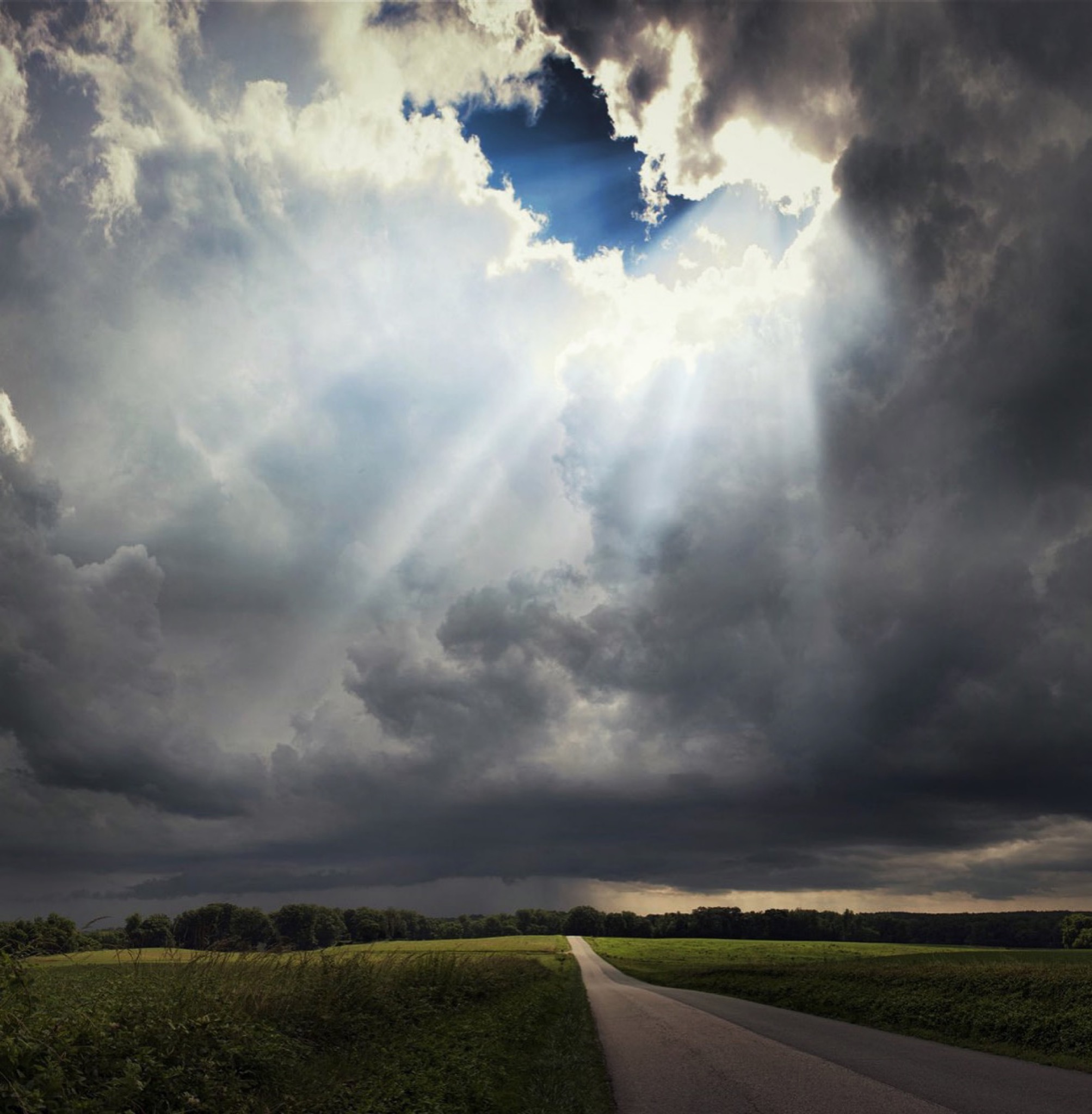
The elect souls will have to fight the Prince of Darkness.
It will be a frightening storm — no, not a storm,
but a hurricane devastating everything!
He even wants to destroy the faith and confidence of the elect.
I will always be beside you in the Storm that is now brewing.
I am your Mother.
I can help you and I want to!
You will see everywhere the light of my Flame of Love
sprouting out like a flash of lightning
illuminating Heaven and earth, and with which I will inflame
even the dark and languid souls!
But what sorrow it is for me to have to watch
so many of my children throw themselves in hell!
—Message from the Blessed Virgin Mary to Elizabeth Kindelmann (1913-1985);
approved by Cardinal Péter Erdö, primate of Hungary
THERE are many sincere and genuine “prophets” in the Protestant churches today. But not surprisingly, there are holes and gaps in some of their “prophetic words” at this hour, precisely because there are holes and gaps in their theological premises. Such a statement is not intended to be inflammatory or triumphalistic, as though “we Catholics” have the corner on God, so to speak. No, the fact is, many Protestant (Evangelical) Christians today have a greater love and devotion to God’s Word than many Catholics, and have cultivated a great zeal, prayer life, faith, and openness to the spontaneity of the Holy Spirit. And thus, Cardinal Ratzinger makes an important qualification of contemporary Protestantism:
Heresy, for Scripture and the early Church, includes the idea of a personal decision against the unity of the Church,
and heresy’s characteristic is pertinacia, the obstinacy of him who persists in his own private way. This, however, cannot be regarded as an appropriate description of the spiritual situation of the Protestant Christian. In the course of a now centuries-old history, Protestantism has made an important contribution to the realization of Christian faith, fulfilling a positive function in the development of the Christian message and, above all, often giving rise to a sincere and profound faith in the individual non-Catholic Christian, whose separation from the Catholic affirmation has nothing to do with the pertinacia characteristic of heresy… The conclusion is inescapable, then: Protestantism today is something different from heresy in the traditional sense, a phenomenon whose true theological place has not yet been determined. —Cardinal Ratzinger (POPE BENEDICT XVI), The Meaning of Christian Brotherhood, pp. 87-88
Perhaps it would serve the body of Christ better to do away with the self-imposed categories of “Protestant prophecy” vs “Catholic prophecy.” For an authentic prophetic word from the Holy Spirit is neither “Catholic” nor “Protestant”, but simply a word to all God’s children. That said, we cannot as easily do away with the real theological divisions that persist that at times do great harm to both private and Public Revelation, either casting God’s Word into a false interpretation or leaving it greatly impoverished. A few examples come to mind, such as those “prophecies” that depict the Catholic Church as the whore of Babylon, the Pope as the “false prophet,” and Mary as a pagan goddess. These are no little distortions, which in fact, have led many souls to even abandon their Catholic faith for a more subjective (and thus precarious) religious experience [that, and I believe that the Great Shaking that is coming is going to rattle everything that is built on sand, that is not founded on The Chair of Rock.[1]Matt 16:18 ]
Furthermore, these distortions have, in many instances, left out the most important aspects of the Great Storm that is upon us: that is, the triumph that is coming. Indeed, some of the most authentic voices in the Evangelical realm almost entirely focus on the coming “judgment” of America and the world. But there is so much more, so much more! But you won’t hear about it in Evangelical circles precisely because the triumph that is coming revolves around the “woman clothed in the sun”, the Blessed Virgin Mary.
HEAD AND BODY
From the beginning, in Genesis, we read how Satan will do battle with this “woman.” And the serpent will be defeated through her “offspring.”
I will put enmity between you [Satan] and the woman, and between your offspring and hers; they will strike at your head, while you strike at their hee
l. (Gen 3:15)
The Latin translation read:
I will put enmity between you and the woman, and your seed and her seed: she shall crush your head, and you shall lie in wait for her heel. (Gen 3:15, Douay-Rheims)
Of this version where Our Lady is depicted as crushing the serpent’s head, Pope John Paul II said:
…this version [in the Latin] does not agree with the Hebrew text, in which it is not the woman but her offspring, her descendant, who will bruise the serpent’s head. This text then does not attribute the victory over Satan to Mary but to her Son. Nevertheless, since the biblical concept establishes a profound solidarity between the parent and the offspring, the depiction of the Immaculata crushing the serpent, not by her own power but through the grace of her Son, is consistent with the original meaning of the passage. — “Mary’s Emnity toward Satan was Absolute”; General Audience, May 29th, 1996; ewtn.com
Indeed, the footnote in the Douay-Rheims agrees: “The sense is the same: for it is by her seed, Jesus Christ, that the woman crushes the serpent’s head.”[2]Footnote, p. 8; Baronius Press Limited, London, 2003 Hence, whatever grace, dignity, and role Our Lady has flows not from herself, as she is a creature, but from the heart of Christ, who is God and Mediator between man and the Father.
…the Blessed Virgin’s salutary influence on men… flows forth from the superabundance of the merits of Christ, rests on His mediation, depends entirely on it, and draws all its power from it. —Catechism of the Catholic Church, n. 970
Hence, it is impossible to separate the mother from the offspring—the child’s victory is also its mother’s. This is realized for Mary at the foot of the Cross when her Son, whom she carried into the world through her fiat, defeats the powers of darkness:
…despoiling the principalities and the powers, he made a public spectacle of them, leading them away in triumph by it. (Col 2:15)
And yet, Jesus made it eminently clear that His followers, His body, would likewise share in the despoiling of principalities and powers:
Behold, I have given you the power ‘to tread upon serpents’ and scorpions and upon the full force of the enemy and nothing will harm you. (Luke 10:19)
How can we not see this as the fulfillment of Genesis 3:15 in which the Woman’s offspring is prophesied to “strike at [Satan’s] head”? Yet, one may ask how it is possible that Christians today are this woman’s “offspring” also? But are we not Christ’s “brother” or “sister”? If so, do we not, then, have a common mother? If He is the “head” and we are His “body”, did Mary give birth only to a head or to a whole body? Let Jesus Himself answer the question: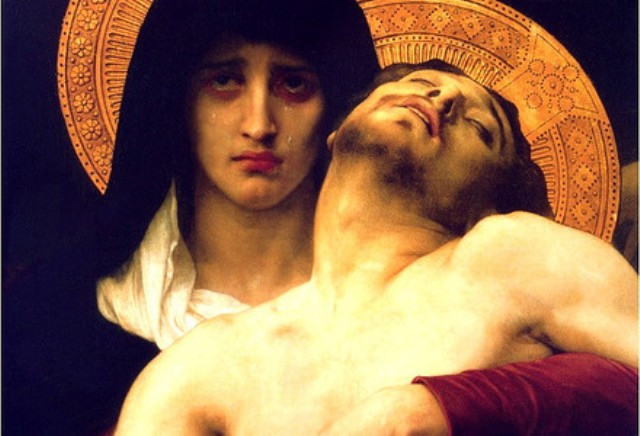
When Jesus saw his mother and the disciple there whom he loved, he said to his mother, “Woman, behold, your son.” Then he said to the disciple, “Behold, your mother.” And from that hour the disciple took her into his home. (John 19:26-27)
Even Martin Luther understood as much.
Mary is the Mother of Jesus and the Mother of all of us even though it was Christ alone who reposed on her knees… If he is ours, we ought to be in his situation; there where he is, we ought also to be and all that he has ought to be ours, and his mother is also our mother. —Martin Luther, Sermon, Christmas, 1529.
Saint John Paul II also notes the significance of the title “Woman” with which Jesus addresses Mary—it is a deliberate echo of the “woman” of Genesis—she who was called Eve…
…because she was the mother of all the living. (Gen 3:20)
The words uttered by Jesus from the Cross signify that the motherhood of her who bore Christ finds a “new” continuation in the Church and through the Church, symbolized and represented by John. In this way, she who as the one “full of grace” was brought into the mystery of Christ in order to be his Mother and thus the Holy Mother of God, through the Church remains in that mystery as “the woman” spoken of by the Book of Genesis (3:15) at the beginning and by the Apocalypse (12:1) at the end of the history of salvation. —POPE JOHN PAUL II, Redemptoris Mater, n. 24
Indeed, in the passage of Revelation 12 describing the “woman clothed in the sun”, we read:
She was with child and wailed aloud in pain as she labored to give birth… Then the dragon stood before the woman about to give birth, to devour her child when she gave birth. She gave birth to a son, a male child, destined to rule all the nations with an iron rod. (Rev 12:2, 4-5)
Who is this child? Jesus, of course. But then Jesus has this to say:
To the victor, who keeps to my ways until the end, I will give authority over the nations. He will rule them with an iron rod… (Rev 2:26-27)
The “child” whom this Woman bears, then, is both Christ the head and His body. Our Lady is giving birth to the whole People of God.
A WOMAN STILL IN LABOR
How do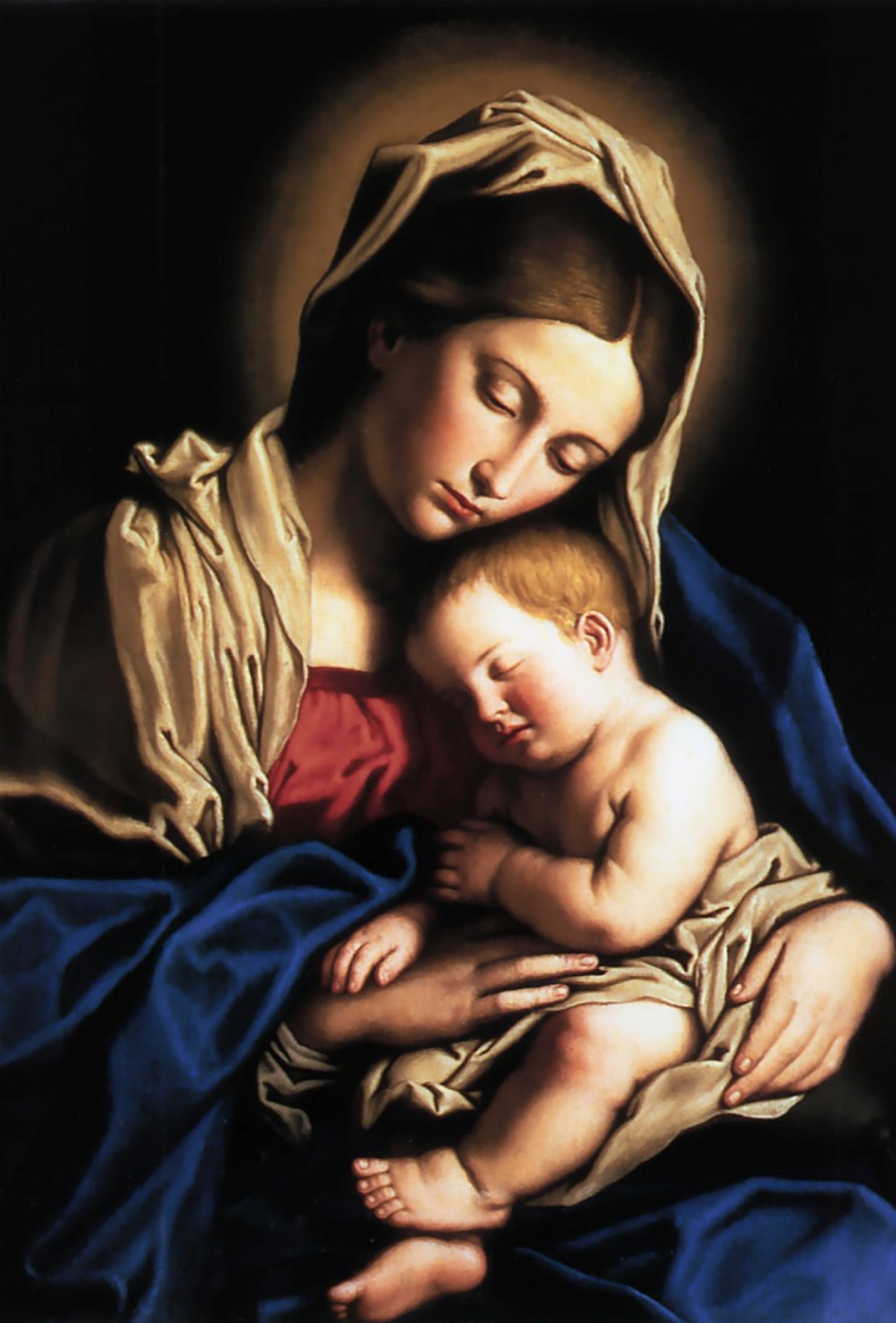 es Mary “give birth” to us? It goes without saying that her motherhood to us is spiritual in nature.
es Mary “give birth” to us? It goes without saying that her motherhood to us is spiritual in nature.
The Church was conceived, so to speak, beneath the Cross. There, a profound symbolism takes place that mirrors the marital act of consummation. For Mary, by perfect obedience, “opens” her heart completely to the will of God. And Jesus, by his perfect obedience, “opens” His heart for the salvation of humanity, which is the will of the Father. Blood and water gushes forth as though “seeding” the Heart of Mary. The Two Hearts are one, and in this profound union in the Divine Will, the Church is conceived: “Woman, behold your son.” It is then, at Pentecost—after the labor of waiting and prayer—that the Church is born in the presence of Mary by the power of the Holy Spirit:
And so, in the redemptive economy of grace, brought about through the action of the Holy Spirit, there is a unique correspondence between the moment of the Incarnation of the Word and the moment of the birth of the Church. The person who links these two moments is Mary: Mary at Nazareth and Mary in the Upper Room at Jerusalem. In both cases her discreet yet essential
presence indicates the path of “birth from the Holy Spirit.” Thus she who is present in the mystery of Christ as Mother becomes—by the will of the Son and the power of the Holy Spirit—present in the mystery of the Church. In the Church too she continues to be a maternal presence, as is shown by the words spoken from the Cross: “Woman, behold your son!”; “Behold, your mother.” —SAINT JOHN PAUL II, Redemptoris Mater, n. 24
Really, Pentecost is a continuation of the Annunciation when Mary was first overshadowed by the Holy Spirit in order to conceive and give birth to a Son. Likewise, what began at Pentecost continues today as more souls are “born again” of Spirit and water—the waters of Baptism that flowed from the Heart of Christ through the Heart of Mary “full of grace” so that she would continue to participate in the birth of the People of God. The genesis of the Incarnation continues as the means by which the Body of Christ is born:
That is the way Jesus is always conceived. That is the way He is reproduced in souls. He is always the fruit of heaven and earth. Two artisans must concur in the work that is at once God’s masterpiece and humanity’s supreme product: the Holy Spirit and the most holy Virgin Mary… for they are the only ones who can reproduce Christ. —Arch. Luis M. Martinez, The Sanctifier, p. 6
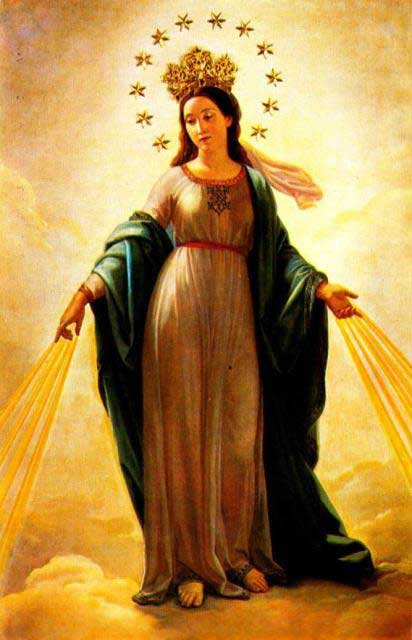 The implications of this profound presence of Mary—by God’s design and free will—places this Woman alongside her Son at the center of salvation history. That is to say, that God not only willed to enter into time and history through a woman, but intends to complete Redemption in the same manner.
The implications of this profound presence of Mary—by God’s design and free will—places this Woman alongside her Son at the center of salvation history. That is to say, that God not only willed to enter into time and history through a woman, but intends to complete Redemption in the same manner.
On this universal level, if victory comes it will be brought by Mary. Christ will conquer through her because He wants the Church’s victories now and in the future to be linked to her… —POPE JOHN PAUL II, Crossing the Threshold of Hope, p. 221
Thus is exposed the “gap” in Protestant prophecy, and that is that this Woman has a role in giving birth to the entire People of God in order to further the reign of God on earth, the reign of the Divine Will “on earth as it is in heaven” before the end of human history. [3]cf. The Coming New and Divine Holiness And this is essentially what was described in Genesis 3:15: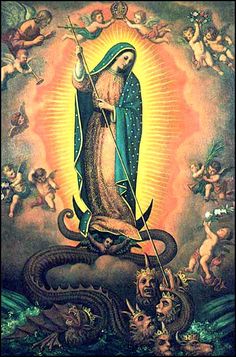 that the Woman’s offspring will crush the serpent’s head—Satan, the “incarnation” of disobedience. This is precisely what St. John foresaw in the last age of the world:
that the Woman’s offspring will crush the serpent’s head—Satan, the “incarnation” of disobedience. This is precisely what St. John foresaw in the last age of the world:
Then I saw an angel come down from heaven, holding in his hand the key to the abyss and a heavy chain. He seized the dragon, the ancient serpent, which is the Devil or Satan, and tied it up for a thousand years and threw it into the abyss, which he locked over it and sealed, so that it could no longer lead the nations astray until the thousand years are completed. After this, it is to be released for a short time. Then I saw thrones; those who sat on them were entrusted with judgment. I also saw the souls of those who had been beheaded for their witness to Jesus and for the word of God, and who had not worshiped the beast or its image nor had accepted its mark on their foreheads or hands. They came to life and they reigned with Christ for a thousand years. (Rev 20:1-4)
Thus, the key to understanding the “end times” lies precisely in understanding the role of Mary, who is a prototype and mirror of the Church.
Knowledge of the true Catholic doctrine regarding the Blessed Virgin Mary will always be a key to the exact understanding of the mystery of Christ and of the Church. —POPE PAUL VI, Discourse of 21 November 1964: AAS 56 (1964) 1015
The Blessed Mother becomes for us then a sign and real 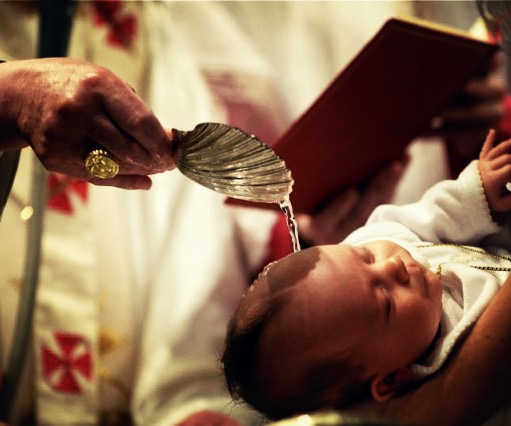 hope of what we the Church is, and is to become: Immaculate.
hope of what we the Church is, and is to become: Immaculate.
At once virgin and mother, Mary is the symbol and the most perfect realization of the Church: “the Church indeed. . . by receiving the word of God in faith becomes herself a mother. By preaching and Baptism she brings forth sons, who are conceived by the Holy Spirit and born of God, to a new and immortal life. She herself is a virgin, who keeps in its entirety and purity the faith she pledged to her spouse.” —Catechism of the Catholic Church, n. 507
Thus, the coming triumph of Mary is at once the triumph of the Church. [4]cf. The Triumph of Mary, Triumph of the Church Lose this key, and you lose the fullness of the prophetic message that God wants His children to hear today—both Protestants and Catholics.
Two-thirds of the world is lost and the other part must pray and make reparation for the Lord to take pity. The devil wants to have full domination over the earth. He wants to destroy. The earth is in great danger… At these moments all humanity is hanging by a thread. If the thread breaks, many will be those who do not reach salvation… Hurry because time is running out; there will be no room for those who delay in coming!… The weapon that has the greatest influence on evil is to say the Rosary… —Our Lady to Gladys Herminia Quiroga of Argentina, approved on May 22nd, 2016 by Bishop Hector Sabatino Cardelli
First published August 17th, 2015.
RELATED READING
The Triumph — Part I, Part II, Part III
You are loved.
To journey with Mark in the The Now Word,
click on the banner below to subscribe.
Your email will not be shared with anyone.
Footnotes
| ↑1 | Matt 16:18 |
|---|---|
| ↑2 | Footnote, p. 8; Baronius Press Limited, London, 2003 |
| ↑3 | cf. The Coming New and Divine Holiness |
| ↑4 | cf. The Triumph of Mary, Triumph of the Church |


